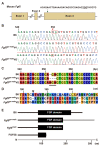Gender-Difference in Hair Length as Revealed by Crispr-Based Production of Long-Haired Mice with Dysfunctional FGF5 Mutations
- PMID: 36233155
- PMCID: PMC9569730
- DOI: 10.3390/ijms231911855
Gender-Difference in Hair Length as Revealed by Crispr-Based Production of Long-Haired Mice with Dysfunctional FGF5 Mutations
Abstract
Fibroblast growth factor 5 (FGF5) is an important molecule required for the transition from anagen to catagen phase of the mammalian hair cycle. We previously reported that Syrian hamsters harboring a 1-bp deletion in the Fgf5 gene exhibit excessive hair growth in males. Herein, we generated Fgf5 mutant mice using genome editing via oviductal nucleic acid delivery (GONAD)/improved GONAD (i-GONAD), an in vivo genome editing system used to target early embryos present in the oviductal lumen, to study gender differences in hair length in mutant mice. The two lines (Fgf5go-malc), one with a 2-bp deletion (c.552_553del) and the other with a 1-bp insertion (c.552_553insA) in exon 3 of Fgf5, were successfully established. Each mutation was predicted to disrupt a part of the FGF domain through frameshift mutation (p.Glu184ValfsX128 or p.Glu184ArgfsX128). Fgf5go-malc1 mice had heterogeneously distributed longer hairs than wild-type mice (C57BL/6J). Notably, this change was more evident in males than in females (p < 0.0001). Immunohistochemical analysis revealed the presence of FGF5 protein in the dermal papilla and outer root sheath of the hair follicles from C57BL/6J and Fgf5go-malc1 mice. Histological analysis revealed that the prolonged anagen phase might be the cause of accelerated hair growth in Fgf5go-malc1 mice.
Keywords: CRISPR/Cas9; GONAD; fibroblast growth factor 5; gender difference; genome editing; hair follicle cycle; indels; long-haired mice.
Conflict of interest statement
The authors have declared that no competing interest exist.
Figures




References
MeSH terms
Substances
LinkOut - more resources
Full Text Sources
Molecular Biology Databases
Research Materials

